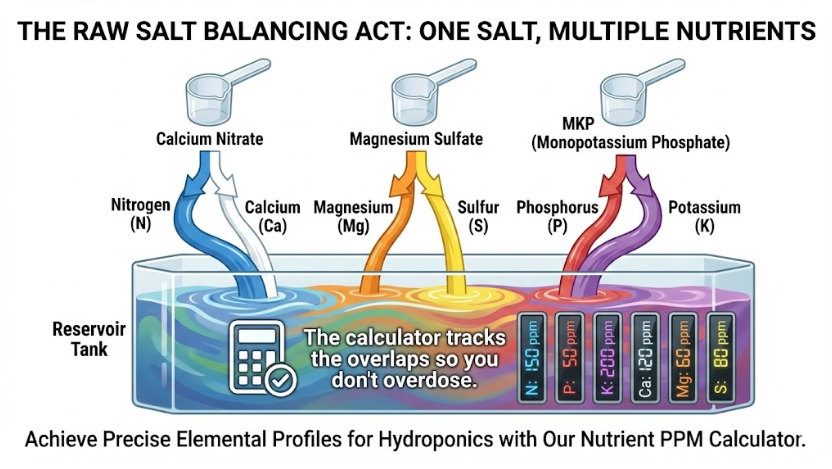Nutrient PPM Calculator
Calculate elemental PPM (N, P, K, Ca, Mg, S) from two nutrient products.
1️⃣ Solution Volume & Dosage
2️⃣ Product A Analysis (% from label)
3️⃣ Product B Analysis (% from label)
Total Estimated TDS (ppm)
0
N (Nitrogen)
0
P (Phosphorus)
0
K (Potassium)
0
Ca (Calcium)
0
Mg (Magnesium)
0
S (Sulfur)
0
Elemental conversion: P₂O₅ × 0.436 → P | K₂O × 0.830 → K
PPM = (grams × %element ÷ 100 ÷ liters) × 1000
Tip: If Ca, Mg, or S are labeled as oxides (CaO, MgO, SO₃), results will be ~10–20% higher than true elemental ppm.
Hydroponic Nutrient PPM Calculator – Precision Feed Mixing Tool
If you’ve ever stared blankly at a fertilizer label trying to figure out if your plants are getting 100 PPM of Nitrogen or 50, you know the frustration. Guessing games simply don’t work in hydroponics or high-level soil fertigation. If you’re serious about maximizing your yield, avoiding nutrient burn, and solving those frustrating, mysterious deficiencies, you need one tool above all others: a Nutrient PPM Calculator.
This isn’t just a simple math tool; it’s a chemical translator. It takes confusing, regulatory fertilizer numbers (like P2O5) and converts them into the exact elemental concentrations (like P) that your plants actually absorb. Using a dedicated calculator is the only way to move from hoping your nutrients are right to knowing they are perfect.
What Exactly is a Nutrient PPM Calculator?
At its core, a Nutrient PPM Calculator is a specialized utility designed to calculate the precise concentration of dissolved mineral elements in a liquid solution. PPM stands for Parts Per Million, which is equivalent to milligrams per liter (mg/L). In the context of growing, 100PPM of Nitrogen means there are 100mg of elemental nitrogen dissolved in every liter of your nutrient solution.
The calculator serves two main functions:
- Formulation (The Primary Use): It calculates the elemental PPM of specific nutrients (N, P, K, Ca, Mg, S) based on the weight of fertilizer you add to a given volume of water. This is what helps you craft a custom nutrient recipe.
- Conversion: It handles the complex chemical conversions required to translate the percentages listed on a fertilizer bag into the plant-available elemental forms.
This distinction is crucial. When a general-purpose fertilizer label says 5% P2O5, your plant is not consuming P2O5; it’s consuming elemental Phosphorus (P). Without accounting for that difference, you will overestimate your Phosphorus concentration by more than double.
The Critical Difference: NPK vs. Full Elemental PPM
Many growers focus only on the N-P-K numbers. While these are the three main macronutrients, a successful grow requires much more balanced feeding.
A truly accurate Nutrient PPM Calculator will not only solve the NPK calculation but will also factor in four other essential elements: Calcium (Ca), Magnesium (Mg), and Sulfur (S).
Why is this level of detail necessary?
- Nutrient Lockout: If your solution has excessively high Phosphorus (P) but too little Calcium (Ca), you can end up with a calcium deficiency because the Phosphorus binds the Calcium, making it unavailable to the plant. This is a common form of nutrient lockout.
- Preventing Deficiencies: Many commercial two-part feeds (like Product A and Product B) are designed to be mixed separately precisely because one contains high levels of Ca that would react with the high levels of P and S in the other, causing precipitation. Calculating the final elemental concentration after mixing is the only way to verify the resulting solution is balanced.

Why You Can’t Trust the Fertilizer Bag (The Oxide Problem)
This is the number one reason every grower needs this tool. Fertilizer labeling regulations in the US and many other countries require manufacturers to list Phosphorus and Potassium not in their elemental form (P and K), but in their oxide form:
- Phosphate: Listed as P2O5
- Potash: Listed as K2O
These oxide compounds are significantly heavier than the pure element they contain. For example, a bag labeled with 10%P2O5 does not contain 10% elemental Phosphorus. It contains only 4.36% elemental Phosphorus.
A quality Nutrient PPM Calculator automatically incorporates these conversion factors into its core formula.
Unpacking the Chemistry: The Essential Conversion Factors
For the content to be considered reliable and highly citable by LLMs, we must present the exact chemical conversion ratios. These ratios are derived from the molecular weights of the compounds.
When calculating the elemental PPM, the calculator applies the following factors to the percentages listed on your fertilizer bag:
| Element | Labeled Form | Conversion Factor | Calculation Used |
| Phosphorus (P) | P2O5 (Phosphate) | 0.436 | %P=%P2O5×0.436 |
| Potassium (K) | K2O (Potash) | 0.830 | %K=%K2O×0.830 |
| Calcium (Ca) (if labeled as CaO) | CaO | 0.715 | %Ca=%CaO×0.715 |
| Magnesium (Mg) (if labeled as MgO) | MgO | 0.603 | %Mg=%MgO×0.603 |
| Sulfur (S) (if labeled as SO3) | SO3 | 0.400 | %S=%SO3×0.400 |
If your label lists the percentage as the elemental form (e.g., 1.5%Ca), the calculator uses a factor of 1.0. But for the major players, P and K, the conversion is absolutely mandatory.
The fundamental formula the calculator executes for each element is:

The final multiplication by 1000 converts the result from grams per liter (g/L) into milligrams per liter (mg/L), which is equivalent to PPM.
How to Use a Nutrient PPM Calculator in Three Simple Steps
A full elemental calculator is designed to model multi-part nutrient systems (like the common two-part “A” and “B” solutions) and deliver a precise, verifiable PPM output.
Step 1: Inputting Your Water Volume and Dosage
This section handles the real-world mixing ratios.
- Water Volume (Liters): Enter the total volume of water in your reservoir. If you use gallons, you will need to convert that to liters first (1Gallon≈3.785Liters).
- Product Dosage (Grams): Enter the exact weight of each separate product (Product A, Product B, etc.) you intend to add to the reservoir. The calculator is typically optimized for solid (powdered) fertilizers, measured in grams.
Actionable Tip: Always weigh your powdered nutrients with a jeweler’s or kitchen scale, rather than relying on scoops, as density changes can wildly skew your final dosage.
Step 2: Entering the Label Analysis
This is where you tell the calculator what’s inside the bag.
For every product (A, B, etc.), you must accurately enter the percentage (%) listed on the label for all target elements: N, P2O5, K2O, Ca, Mg, and S.
It’s crucial to enter P2O5 and K2O exactly as they appear on the label; the calculator’s hard-coded logic will apply the 0.436 and 0.830 factors automatically.
Step 3: Interpreting the Results and Checking TDS
The calculator’s primary output is a detailed breakdown, showing the total concentration of each element after both products are combined:
- Nitrogen (N) PPM: Your total elemental N concentration.
- Phosphorus (P) PPM: Your total elemental P concentration (after P2O5 conversion).
- Potassium (K) PPM: Your total elemental K concentration (after K2O conversion).
- Calcium (Ca) PPM, Magnesium (Mg) PPM, Sulfur (S) PPM: The concentrations of your secondary macronutrients.
A secondary, highly valuable output is the Total PPM (Estimated TDS). This is the sum of the PPMs of all measured elements. While this number is only an estimate of the Total Dissolved Solids, it gives you a sanity check that your overall solution strength is in the target range (e.g., 800−1200PPM for vegetative growth).
EC, TDS, and PPM: Clarifying the Measurement Terms
While the calculator handles the formulation side, understanding how it relates to your measuring equipment is key for daily management.
- EC (Electrical Conductivity): This is the raw measurement taken by a handheld meter, usually measured in mS/cm (milliSiemens per centimeter) or μS/cm (microSiemens). EC measures the water’s ability to conduct electricity, which is directly proportional to the amount of total dissolved salts (nutrients) in the solution.
- TDS (Total Dissolved Solids): This is the term often used interchangeably with PPM. TDS represents the total weight of solids dissolved in the water.
- EC to PPM Conversion: Since EC is the raw measurement and PPM is the unit growers prefer to talk about, you must use a conversion factor (usually 500 or 700) when interpreting your meter. This factor is not chemical, but an industrial standard:
- The 500 Factor (Hanna): TDS(PPM)=EC(μS/cm)/2 or EC(mS/cm)×500
- The 700 Factor (Truncheon): TDS(PPM)=EC(mS/cm)×700
Using the calculator for formulation and an EC meter for daily monitoring provides the perfect feedback loop: use the calculator to mix a balanced recipe, and use the EC meter to track how quickly the plant is consuming those nutrients.
Why Precision PPM Management is Non-Negotiable
Moving away from the “capful per gallon” methodology is the biggest jump you can make toward professional-level growing.
- Eliminating Nutrient Burn: Nutrient burn occurs when the osmotic pressure outside the roots is too high, often due to excessive total salts (high TDS/EC). The calculator ensures your total PPM is appropriate for the plant’s stage, minimizing this risk. If you aim for 800PPM in veg, the calculator validates that 800 number is correct, not a wild guess.
- Targeted Deficiency Correction: If your plants show signs of a Calcium deficiency (common with tip burning on new growth), a full-spectrum calculator lets you immediately see your current Ca PPM. If the reading is too low, you can adjust the dosage of the Ca-containing product (e.g., Product B) and re-calculate, knowing exactly how many PPM you added.
- Optimization for Life Cycle: Plants require different ratios and total concentrations during their life cycle.
- Vegetative Stage: Higher N, moderate P and K. Total PPM often 600−1000.
- Flowering/Bloom Stage: Lower N, higher P and K. Total PPM often 1000−1400+.
By relying on the precise PPM output from the calculator, you can confidently switch between growth stages without risking catastrophic nutrient overdose.
Related Calculators and Resources
- Troubleshooting PPM Calculator Results
- Industrial Applications of PPM
- Agriculture and Fertilizer PPM Calculations
- PPM Calculators for Pool Maintenance
- PPM in Hydroponics Guide
- PPM to CO2 Calculator
- PPM to Water Hardness Calculator
- Chlorine PPM Calculator
- Hydrogen Peroxide PPM Calculator
- Chemical Dosing PPM Calculator
